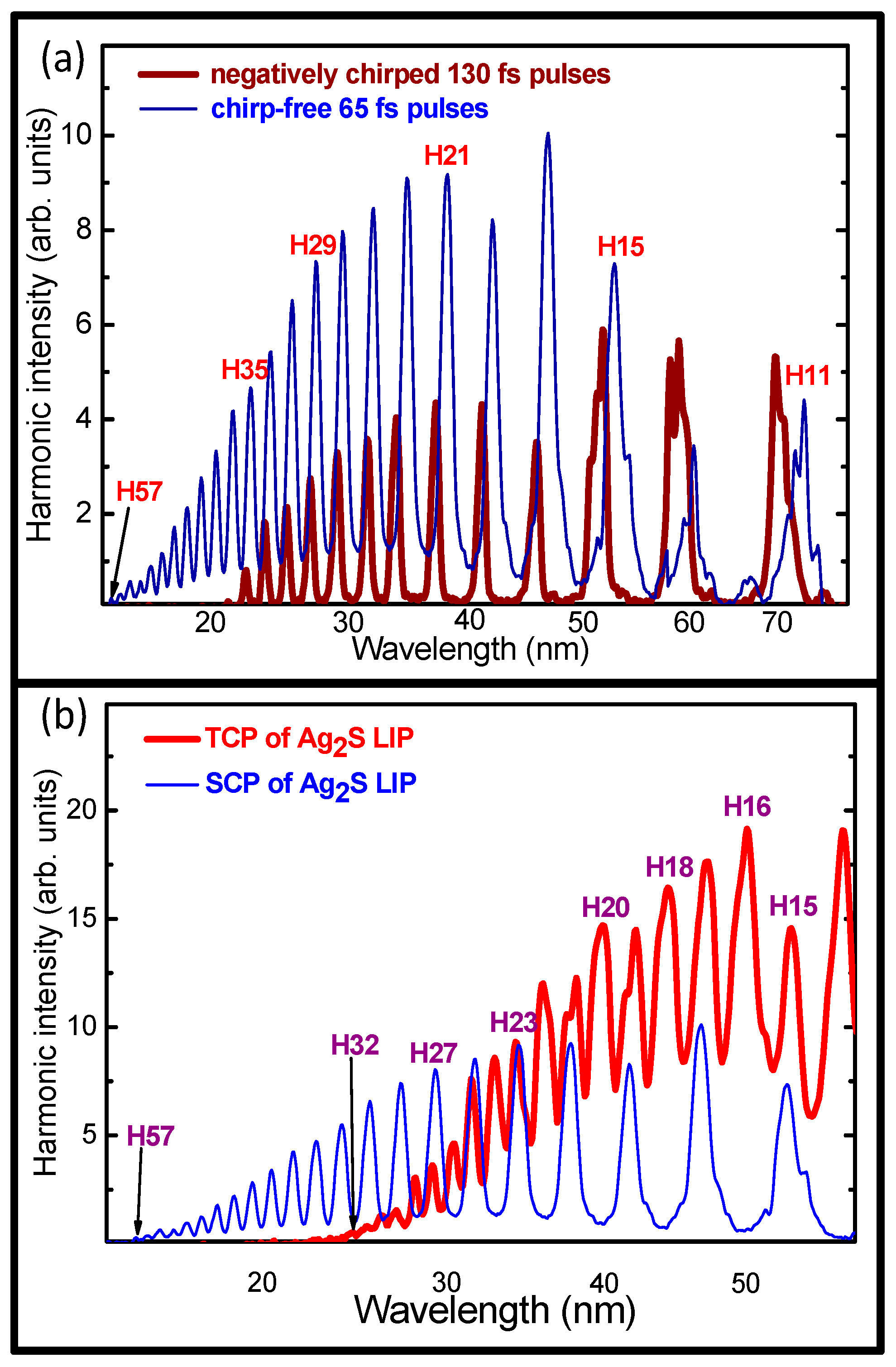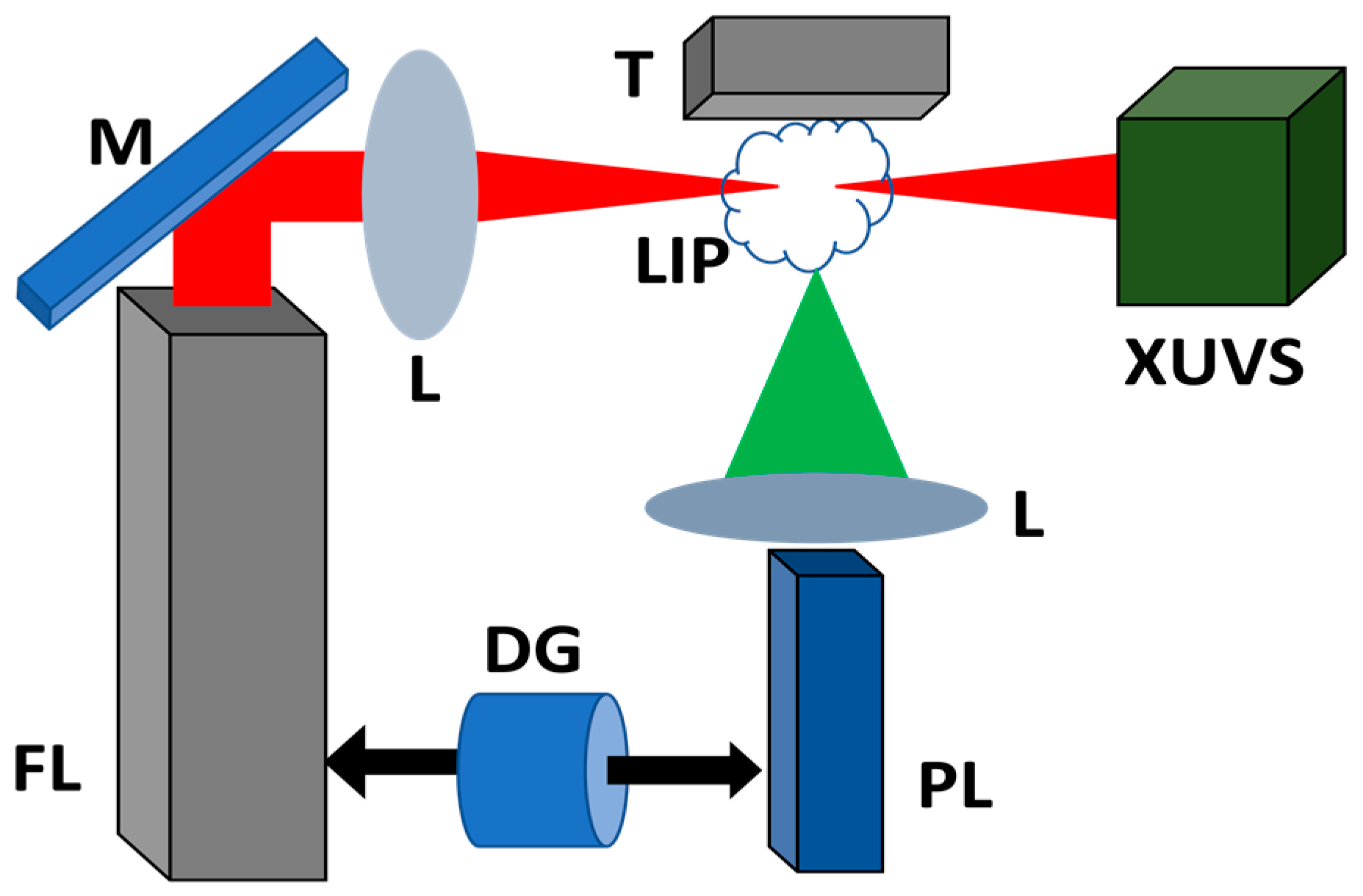Harmonic Generation in Molecular Ag2S Plasma
Abstract
:1. Introduction
2. Results
2.1. Comparison of HHG in Ag2S and Ag Plasmas
2.2. Analysis of Harmonic Modification in Silver Sulfide Plasma Using Variable Driving Pulses and LIP Structure
3. Discussion
4. Methods and Materials
5. Conclusions
Funding
Institutional Review Board Statement
Informed Consent Statement
Data Availability Statement
Acknowledgments
Conflicts of Interest
References
- Aravind, A.; Jayaraj, M.K.; Kumar, M.; Chandra, R. The dependence of structural and optical properties of PLD grown ZnO films on ablation parameters. Appl. Surf. Sci. 2023, 286, 54–60. [Google Scholar] [CrossRef]
- Lorusso, A.; Nassisi, V.; Congedo, G.; Lovergine, N.; Velardi, L.; Prete, P. Pulsed plasma ion source to create Si nanocrystals in SiO2 substrates. Appl. Surf. Sci. 2009, 255, 5401–5404. [Google Scholar] [CrossRef]
- Stefan, N.; Mulenko, S.A.; Skoryk, M.A.; Popov, V.M.; Smirnov, A.B. Influence of hybrid Fe/Cr parameters structures synthesised with laser radiation on their photosensitivity. J. Mater. Sci. Mater. Electron. 2023, 34, 1830. [Google Scholar] [CrossRef]
- Elouga Bom, L.B.; Pertot, Y.; Bhardwaj, V.R.; Ozaki, T. Multi-µJ coherent extreme ultraviolet source generated from carbon using the plasma harmonic method. Opt. Express 2011, 19, 3077–3085. [Google Scholar] [CrossRef] [PubMed]
- Sheinfux, A.H.; Henis, Z.; Levin, M.; Zigler, A. Plasma structures for quasiphase matched high harmonic generation. Appl. Phys. Lett. 2011, 98, 141110. [Google Scholar] [CrossRef]
- Haessler, S.; Strelkov, V.; Elouga Bom, L.B.; Khokhlova, M.; Gobert, O.; Hergott, J.-F.; Lepetit, F.; Perdrix, M.; Ozaki, T.; Salieres, P. Phase distortions of attosecond pulses produced by resonance-enhanced high harmonic generation. New J. Phys. 2013, 15, 013051. [Google Scholar] [CrossRef]
- Singhal, H.; Naik, P.A.; Kumar, M.; Chakera, J.A.; Gupta, P.D. Enhanced coherent extreme ultraviolet emission through high order harmonic generation from plasma plumes containing nanoparticles. J. Appl. Phys. 2014, 115, 033104. [Google Scholar] [CrossRef]
- Rosenthal, N.; Marcus, G. Discriminating between the role of phase matching and that of the single-atom response in resonance plasma-plume high-order harmonic generation. Phys. Rev. Lett. 2015, 115, 133901. [Google Scholar] [CrossRef] [PubMed]
- Fareed, M.A.; Thire, N.; Mondal, S.; Schmidt, B.E.; Legare, F.; Ozaki, T. Efficient generation of sub-100 eV high-order harmonics from carbon molecules using infrared laser pulses. Appl. Phys. Lett. 2016, 108, 124104. [Google Scholar] [CrossRef]
- Abdelrahman, Z.; Khohlova, M.A.; Walke, D.J.; Witting, T.; Zair, A.; Strelkov, V.V.; Marangos, J.P.; Tisch, J.W.G. Chirp-control of resonant high-order harmonic generation in indium ablation plumes driven by intense few-cycle laser pulses. Opt. Express 2018, 26, 15745–15758. [Google Scholar] [CrossRef]
- Wahyutama, S.; Sato, T.; Ishikawa, K.L. Time-dependent multiconfiguration self-consistent-field study on resonantly enhanced high-order harmonic generation from transition-metal elements. Phys. Rev. A 2019, 99, 063420. [Google Scholar] [CrossRef]
- Liang, J.; Lai, Y.H.; Fu, W.; Shan, Y.; Yu, W.; Guo, C. Observation of resonance-enhanced high-order harmonics from direct excitation of metal nanoparticles with femtosecond pulses. Phys. Rev. A 2020, 102, 053117. [Google Scholar] [CrossRef]
- McPherson, A.; Ginson, G.; Jara, H.; Johann, N.; McIntyre, I.A.; Boyer, K.; Rhodes, C.K. Studies of multiphoton production of vacuum-ultraviolet radiation in the rare gases. J. Opt. Soc. Am. B 1987, 4, 595–601. [Google Scholar] [CrossRef]
- Dromey, B.; Zepf, M.; Gopal, A.; Lancaster, K.; Wei, M.S.; Krushelnick, K.; Tatarakis, M.; Vakakis, N.; Moustaizis, S.; Kodama, R.; et al. High harmonic generation in the relativistic limit. Nat. Phys. 2006, 2, 456–459. [Google Scholar] [CrossRef]
- Quéré, F.; Thaury, C.; Monot, P.; Dobosz, S.; Martin, P.; Geindre, J.-P.; Audebert, P. Coherent wake emission of high-order harmonics from overdense plasmas. Phys. Rev. Lett. 2006, 96, 125004. [Google Scholar] [CrossRef] [PubMed]
- Ghimire, S.; DiChiara, A.D.; Sistrunk, E.; Agostini, P.; DiMauro, L.F.; Reis, D.A. Observation of high-order harmonic generation in a bulk crystal. Nat. Phys. 2011, 7, 138–141. [Google Scholar] [CrossRef]
- Singhal, H.; Arora, V.; Rao, B.S.; Naik, P.A.; Chakravarty, U.; Khan, R.A.; Gupta, P.D. Dependence of high-order harmonic intensity on the length of preformed plasma plumes. Phys. Rev. A 2009, 79, 023807. [Google Scholar] [CrossRef]
- Pertot, Y.; Chen, S.; Khan, S.D.; ElougaBom, L.B.; Ozaki, T.; Chang, Z. Generation of continuum high-order harmonics from carbon plasma using double optical gating. J. Phys. B 2012, 45, 074017. [Google Scholar] [CrossRef]
- Kumar, M.; Singhal, H.; Chakera, J.A.; Naik, P.A.; Khan, R.A.; Gupta, P.D. Study of the spatial coherence of high order harmonic radiation generated from preformed plasma plumes. J. Appl. Phys. 2013, 114, 033112. [Google Scholar] [CrossRef]
- Fareed, M.A.; Strelkov, V.V.; Thire, N.; Mondal, S.; Schmidt, B.E.; Legare, F.; Ozaki, T. High-order harmonic generation from the dressed autoionizing states. Nat. Commun. 2017, 8, 16061. [Google Scholar] [CrossRef]
- Wostmann, M.; Splitthoff, L.; Zacharias, H. Control of quasiphase-matching of high-harmonics in a spatially structured plasma. Opt. Express 2018, 26, 14524–14537. [Google Scholar] [CrossRef] [PubMed]
- Singh, M.; Fareed, M.A.; Laramee, A.; Isgandarov, E.; Ozaki, T. Intense vortex high-order harmonics generated from laser-ablated plume. Appl. Phys. Lett. 2019, 115, 231105. [Google Scholar] [CrossRef]
- Konda, S.R.; Soma, V.R.; Banavoth, M.; Ketavath, R.; Mottamchetty, V.; Lai, Y.H.; Li, W. High harmonic generation from laser-induced plasmas of Ni-doped CsPbBr3 nanocrystals: Implications for extreme ultraviolet light sources. ACS Appl. Nano Mater. 2021, 4, 8292–8301. [Google Scholar] [CrossRef]
- Konda, S.R.; Lai, Y.H.; Li, W. Investigation of high harmonic generation from laser ablated plumes of silver. J. Appl. Phys. 2021, 130, 013101. [Google Scholar] [CrossRef]
- Singh, M.; Fareed, M.A.; Strelkov, V.; Grum-Grzhimailo, A.N.; Magunov, A.I.; Laramee, A.; Legare, F.; Ozaki, T. Intense quasi-monochromatic resonant harmonic generation in the multiphoton ionization regime. Optica 2021, 8, 1122–1125. [Google Scholar] [CrossRef]
- Fu, W.; Lai, Y.H.; Liang, J.; Li, W. Investigation of high-harmonic cutoff of metal ions driven by near-infrared laser. Opt. Express 2022, 30, 23090–23101. [Google Scholar] [CrossRef] [PubMed]
- Fu, W.; Lai, Y.H.; Li, W. Comparative study of medium length-dependent high-harmonic generation from metal ions. Opt. Express 2022, 30, 47315–47325. [Google Scholar] [CrossRef]
- Ganeev, R.A.; Suzuki, M.; Baba, M.; Kuroda, H.; Ozaki, T. Strong resonance enhancement of a single harmonic generated in extreme ultraviolet range. Opt. Lett. 2006, 31, 1699–1701. [Google Scholar] [CrossRef] [PubMed]
- Kim, V.V.; Boltaev, G.S.; Iqbal, M.; Abbasi, N.A.; Al-Harmi, H.; Wahyutama, I.S.; Sato, T.; Ishikawa, K.L.; Ganeev, R.A.; Alnaser, A.S. Resonance enhancement of harmonics in the vicinity of 32 nm spectral range during propagation of femtosecond pulses through the molybdenum plasma. J. Phys. B 2020, 53, 195401. [Google Scholar] [CrossRef]
- Ganeev, R.A.; Mirzaev, B.S. Atomic versus molecular plasmas for frequency conversion of laser radiation: Stronger harmonics, larger cutoffs, better stability, resonance and quasi-phase-matching enhancement. Appl. Phys. B 2024, 130, 72. [Google Scholar] [CrossRef]
- Ganeev, R.A. Laser-induced molecular plasma: A medium for high-order harmonics generation of ultrashort pulses. Int. J. Molec. Sci. 2022, 23, 7613. [Google Scholar] [CrossRef]
- Elouga Bom, L.B.; Kieffer, J.-C.; Ganeev, R.A.; Suzuki, M.; Kuroda, H.; Ozaki, T. Influence of the main pulse and prepulse intensity on high-order harmonic generation in silver plasma ablation. Phys. Rev. A 2007, 75, 033804. [Google Scholar] [CrossRef]
- Tosa, V.; Kim, H.T.; Kim, I.J.; Nam, C.H. High-order harmonic generation by chirped and self-guided femtosecond laser pulses. II. Time-frequency analysis. Phys. Rev. A 2005, 71, 063808. [Google Scholar] [CrossRef]
- Froud, C.A.; Rogers, E.T.F.; Hanna, D.C.; Brocklesby, W.C.; Praeger, M.; de Paula, A.M.; Baumberg, J.J. Soft-x-ray wavelength shift induced by ionization effects in a capillary. Opt. Lett. 2006, 31, 374–376. [Google Scholar] [CrossRef] [PubMed]
- Kim, H.T.; Tosa, V.; Nam, C.H. Synchronized generation of bright high-order harmonics using self-guided and chirped femtosecond laser pulses. J. Phys. B 2006, 39, S265. [Google Scholar] [CrossRef]
- Ganeev, R.A.; Suzuki, M.; Kuroda, H. Enhanced harmonic generation using different second-harmonic sources for the two-color pump of extended laser-produced plasmas. J. Opt. Soc. Am. B 2014, 31, 911–918. [Google Scholar] [CrossRef]
- Krausz, F.; Ivanov, M. Attosecond physics. Rev. Mod. Phys. 2009, 81, 163–234. [Google Scholar] [CrossRef]




| Optimal Delay | Ratio of Intensities (IAg2S/IAg) from Ag2S and Ag LIP | Optimal Fluence of 70 ps Heating Pulses | Intensity of 806 nm Driving Pulses | Harmonic Cutoff | Harmonic Shift for Chirped Driving Pulses | TCP-Induced Enhancement of Low-Order Harmonics | Optimal Distance from Target | Ratio of Harmonic Intensities (I5mm Ag2S/I0.3mm Ag2S) Using LIPs of Different Length |
|---|---|---|---|---|---|---|---|---|
| 110 ns | 4 (H11) 10 (H49) | 0.28 J cm−2 | 3 × 1014 W cm−2 | H59 | 2 nm (H11) 0.3 nm (H33) | 2× | 0.25 mm | 2 (H13) 0.15 (H51) |
Disclaimer/Publisher’s Note: The statements, opinions and data contained in all publications are solely those of the individual author(s) and contributor(s) and not of MDPI and/or the editor(s). MDPI and/or the editor(s) disclaim responsibility for any injury to people or property resulting from any ideas, methods, instructions or products referred to in the content. |
© 2024 by the author. Licensee MDPI, Basel, Switzerland. This article is an open access article distributed under the terms and conditions of the Creative Commons Attribution (CC BY) license (https://creativecommons.org/licenses/by/4.0/).
Share and Cite
Ganeev, R.A. Harmonic Generation in Molecular Ag2S Plasma. Int. J. Mol. Sci. 2024, 25, 8106. https://doi.org/10.3390/ijms25158106
Ganeev RA. Harmonic Generation in Molecular Ag2S Plasma. International Journal of Molecular Sciences. 2024; 25(15):8106. https://doi.org/10.3390/ijms25158106
Chicago/Turabian StyleGaneev, Rashid A. 2024. "Harmonic Generation in Molecular Ag2S Plasma" International Journal of Molecular Sciences 25, no. 15: 8106. https://doi.org/10.3390/ijms25158106
APA StyleGaneev, R. A. (2024). Harmonic Generation in Molecular Ag2S Plasma. International Journal of Molecular Sciences, 25(15), 8106. https://doi.org/10.3390/ijms25158106





